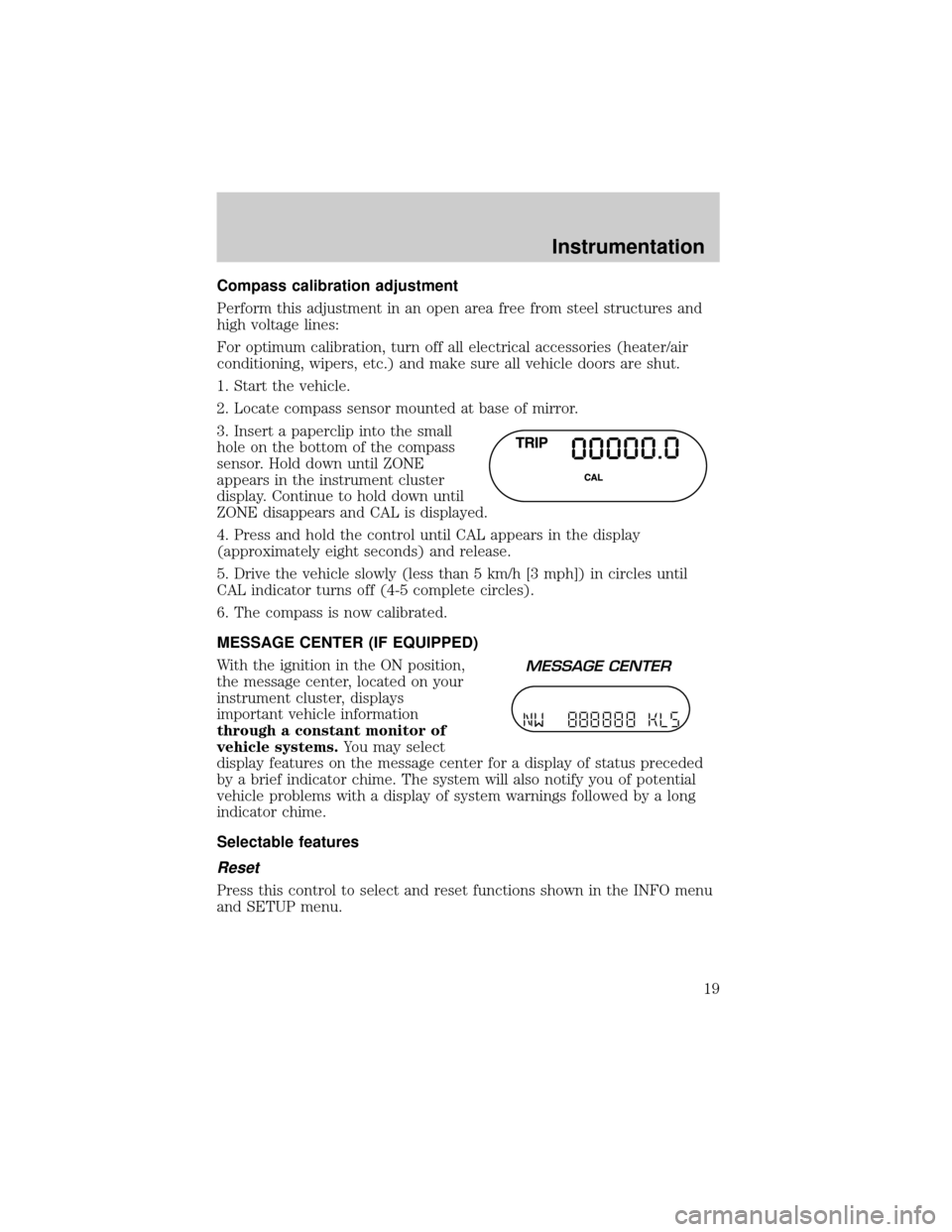heater FORD EXPLORER 2002 3.G Owners Manual
[x] Cancel search | Manufacturer: FORD, Model Year: 2002, Model line: EXPLORER, Model: FORD EXPLORER 2002 3.GPages: 312, PDF Size: 3.28 MB
Page 19 of 312

Compass calibration adjustment
Perform this adjustment in an open area free from steel structures and
high voltage lines:
For optimum calibration, turn off all electrical accessories (heater/air
conditioning, wipers, etc.) and make sure all vehicle doors are shut.
1. Start the vehicle.
2. Locate compass sensor mounted at base of mirror.
3. Insert a paperclip into the small
hole on the bottom of the compass
sensor. Hold down until ZONE
appears in the instrument cluster
display. Continue to hold down until
ZONE disappears and CAL is displayed.
4. Press and hold the control until CAL appears in the display
(approximately eight seconds) and release.
5. Drive the vehicle slowly (less than 5 km/h [3 mph]) in circles until
CAL indicator turns off (4-5 complete circles).
6. The compass is now calibrated.
MESSAGE CENTER (IF EQUIPPED)
With the ignition in the ON position,
the message center, located on your
instrument cluster, displays
important vehicle information
through a constant monitor of
vehicle systems.You may select
display features on the message center for a display of status preceded
by a brief indicator chime. The system will also notify you of potential
vehicle problems with a display of system warnings followed by a long
indicator chime.
Selectable features
Reset
Press this control to select and reset functions shown in the INFO menu
and SETUP menu.
Instrumentation
19
Page 20 of 312

Info menu
This control displays the following
control displays:
²Odometer/Compass
²Trip odometer/Odometer/Compass
²Distance to Empty
²Average Fuel Economy
Odometer/Trip odometer
Refer toGaugesin this chapter.
Compass display
The compass reading may be affected when you drive near large
buildings, bridges, power lines and powerful broadcast antenna. Magnetic
or metallic objects placed in, on or near the vehicle may also affect
compass accuracy.
Usually, when something affects the compass readings, the compass will
correct itself after a few days of operating your vehicle in normal
conditions. If the compass still appears to be inaccurate, a manual
calibration may be necessary. Refer toCompass zone/calibration
adjustment.
Most geographic areas (zones) have a magnetic north compass point that
varies slightly from the northerly direction on maps. This variation is four
degrees between adjacent zones and will become noticeable as the
vehicle crosses multiple zones. A correct zone setting will eliminate this
error. Refer toCompass zone/calibration adjustment.
Compass zone/calibration adjustment
Perform this adjustment in an open area free from steel structures and
high voltage lines.
For optimum calibration, turn off all electrical accessories (heater/air
conditioning, wipers, etc.) and make sure all vehicle doors are shut.
1. Turn ignition to the ON position.
2. Start the engine.
INFO
SETUP
RESET
Instrumentation
20
Page 174 of 312

Cold weather starting (flexible fuel vehicles only)
As the outside temperature approaches freezing, ethanol fuel distributors
should supply winter grade ethanol (same as with unleaded gasoline). If
summer grade ethanol is used in cold weather conditions, you may
experience increased cranking times, rough idle or hesitation until the
engine has warmed up. Consult your fuel distributor for the availability of
winter grade ethanol.
Do not crank the engine for more than 30 seconds at a time as starter
damage may occur. If the engine fails to start, turn the key to OFF and
wait 30 seconds before trying again.
Do not use starting fluid such as ether in the air intake system (see Air
Cleaner Decal). Such fluid could cause immediate explosive damage to
the engine and possible personal injury.
If you should experience cold weather starting problems on ethanol, and
neither an alternative brand of ethanol nor an engine block heater is
available, the addition of unleaded gasoline to your tank will improve
cold starting performance. Your vehicle is designed to operate on ethanol
alone, unleaded gasoline alone, or any mixture of the two.
SeeChoosing the right fuelin theMaintenance and carechapter for
more information on diesel fuel.
If the engine fails to start using the preceding instructions
1. Press the accelerator pedal 1/3 to 1/2 of the way to floor and hold.
2. Turn the key to START position.
3. When the engine starts, release the key, then release the accelerator
pedal gradually as the engine speeds up.
4. If the engine still fails to start, repeat steps one through three.
5. After the engine starts, hold your foot on the brake pedal, put the
gearshift lever in gear and release the parking brake. Slowly release the
brake pedal and drive away in a normal manner.
Using the engine block heater (if equipped)
An engine block heater warms the engine coolant, which improves
starting, warms up the engine faster and allows the heater-defroster
system to respond quickly. Use of an engine block heater is strongly
recommended if you live in a region where temperatures reach -23ÉC
(-10ÉF) or below.
Starting
174
Page 175 of 312

For best results, plug the heater in at least three hours before starting
the vehicle. Using the heater for longer than three hours will not harm
the engine, so the heater can be plugged in the night before starting the
vehicle.
To prevent electrical shock, do not use your heater with
ungrounded electrical systems or two-pronged (cheater)
adapters.
Guarding against exhaust fumes
Although odorless and colorless, carbon monoxide is present in exhaust
fumes. Take precautions to avoid its dangerous effects.
If you ever smell exhaust fumes of any kind inside your vehicle,
have your dealer inspect and fix your vehicle immediately. Do
not drive if you smell exhaust fumes. These fumes are harmful and
could kill you.
Have the exhaust and body ventilation systems checked whenever:
²the vehicle is raised for service.
²the sound of the exhaust system changes.
²the vehicle has been damaged in a collision.
WARNING:Engine exhaust, some of its constituents, and
certain vehicle components contain or emit chemicals known to
the State of California to cause cancer and birth defects or other
reproductive harm. In addition, certain fluids contained in vehicles and
certain products of component wear contain or emit chemicals known
to the State of California to cause cancer and birth defects or other
reproductive harm.
Important ventilating information
If the engine is idling while the vehicle is stopped in an open area for
long periods of time, open the windows at least 2.5 cm (one inch).
Adjust the heating or air conditioning (if equipped) to bring in fresh air.
Improve vehicle ventilation by keeping all air inlet vents clear of snow,
leaves and other debris.
Starting
175
Page 223 of 312

Do not attempt to push start your vehicle. Automatic
transmissions do not have push-start capability.
Preparing your vehicle
When the battery is disconnected or a new battery is installed, the
transmission must relearn its adaptive strategy. As a result of this, the
transmission may shift firmly. This operation is considered normal and
will not effect function or durability of the transmission. Over time, the
adaptive learning process will fully update transmission operation to its
optimum shift feel.
1.Use only a 12±volt supply to start your vehicle.
2. Do not disconnect the battery of the disabled vehicle as this could
damage the vehicle's electrical system.
3.
Park the booster vehicle close to the hood of the disabled vehicle
making sure the two vehiclesdo nottouch. Set the parking brake on both
vehicles and stay clear of the engine cooling fan and other moving parts.
4. Check all battery terminals and remove any excessive corrosion before
you attach the battery cables. Ensure that vent caps are tight and level.
5. Turn the heater fan on in both vehicles to protect any electrical
surges. Turn all other accessories off.
Connecting the jumper cables
1. Connect the positive (+) booster cable to the positive (+) terminal of
the discharged battery.
Note:In the illustrations,lightning boltsare used to designate the
assisting (boosting) battery.
+–+–
Roadside emergencies
223
Page 300 of 312

Comfort and convenience
Cargo net
Cargo organizers
Cargo shade
Cargo tray
Engine block heaters
Tire step
Travel equipment
Automatic headlamps with daytime running lights (DRL)
Cellular phone holder
Daytime running lights (DRL)
Factory luggage rack adaptors (bike and ski)
Heavy-duty battery
Home link visor
Inside mirror, electrochromic compass (with and without temperature
display)
Luggage/Cargo basket
Luggage rack cross bars
Neutral towing transfer case kit
Dog guard
Removable luggage rack adapters (bike and ski)
Running boards/bars
Seatback storage
Smoker's package
Soft luggage cover
Track rider bars (for luggage rack)
Trailer hitch (Class III)
Trailer hitch bars and balls
Trailer hitch mount bike carrier
Trailer hitch receiver cover
Trailer hitch wiring adaptor
Customer assistance
300
Page 304 of 312

A
Air bag supplemental
restraint system ................155, 159
and child safety seats ............157
description ......................155, 159
disposal ....................................162
driver air bag ..................157, 160
indicator light ...........10, 159, 161
operation .........................157, 160
passenger air bag ...........157, 160
side air bag ..............................159
Air cleaner filter .......................283
Air conditioning ..........................33
automatic temperature
control system ..........................37
auxiliary heater and air
conditioner ................................46
rear seat controls .....................47
Ambulance packages ....................3
Antifreeze
(see Engine coolant) ................241
Anti-lock brake system
(see Brakes) ......................176±177
Anti-theft system ......................125
arming the system ..................125
disarming a
triggered system .....................126
warning light .............................11
Audio system (see Radio) ...51, 74
Automatic transmission
driving an automatic
overdrive .................................182
fluid, adding ............................248
fluid, checking ........................248
fluid, refill capacities ..............283
fluid, specification ..................287
Auxiliary power point ...............112Axle
lubricant specifications ..285, 287
refill capacities ........................283
traction lok ..............................194
B
Battery .......................................251
acid, treating emergencies .....251
charging system
warning light .............................11
jumping a disabled battery ....222
maintenance-free ....................251
replacement, specifications ...283
servicing ..................................251
voltage gauge ............................16
Belt minder ...............................151
Brakes ........................................176
anti-lock ...........................176±177
anti-lock brake system
(ABS) warning light .........11, 177
brake warning light ..................10
fluid, checking and adding ....240
fluid, refill capacities ..............283
fluid, specifications .........285, 287
lubricant specifications ..285, 287
parking ....................................177
pedals (see Power
adjustable foot pedals) ............30
shift interlock ..........................180
Break-in period .............................3
C
Capacities for refilling fluids ....283
Cargo cover ...............................115
Certification Label ....................289
Child safety restraints ..............162
child safety belts ....................162
Index
304
Page 306 of 312

through water .................192, 196
E
Electronic message center .........19
Emergencies, roadside
jump-starting ..........................222
Emission control system ..........268
Engine ........................................287
check engine/
service engine soon light ...........8
cleaning ...................................278
coolant .....................................241
fail-safe coolant ......................246
idle speed control ...................251
lubrication
specifications ..................285, 287
refill capacities ........................283
service points ..................233±234
starting after a collision .........206
Engine block heater .................174
Engine oil ..................................235
checking and adding ..............235
dipstick ....................................235
filter, specifications ........238, 283
recommendations ...................238
refill capacities ........................283
specifications ..................285, 287
Exhaust fumes ..........................175
F
Fail safe cooling ........................246
Floor mats .................................114
Fluid capacities .........................283
Foglamps .....................................28
Four-Wheel Drive
vehicles ................................12, 187control trac .......................50, 188
description ......................188, 190
driving off road .......................191
electronic shift ..........................50
preparing to
drive your vehicle ...................179
Fuel ............................................259
calculating
fuel economy ....................22, 265
cap .....................................10, 264
capacity ...................................283
choosing the right fuel ...........261
comparisons with EPA
fuel economy estimates .........268
detergent in fuel .....................263
filling your vehicle
with fuel ..................259, 264±265
filter, specifications ........265, 283
fuel pump shut-off switch .....206
gauge .........................................17
improving fuel economy ........265
octane rating ...................262, 287
quality ......................................262
running out of fuel .................263
safety information relating
to automotive fuels ................259
Fuses ..................................207, 209
G
Garage door opener ..........101, 103
Gas cap (see Fuel cap) ......10, 264
Gas mileage
(see Fuel economy) .................265
Gauges ...................................13±14
battery voltage gauge ...............16
engine coolant
temperature gauge ...................14
engine oil pressure gauge ........16
fuel gauge ..................................17
Index
306